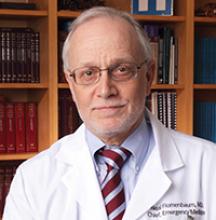User login
Angry ED patients, or family members, are angry for a variety of reasons. Some arrive angry, but many more become angry waiting to be seen by an EP, waiting for lab results or a consult, waiting for an inpatient bed, or waiting to be discharged. Persistent pain, hunger, overcrowded ED conditions, and harried staff are ingredients for potential explosions among even those patients who do not arrive intoxicated, hypoxic, febrile, delirious, demented, or psychotic.
In a 1998 perspective on aggression and violence directed toward physicians, (J Gen Intern Med. 1998;13[8]:556-561), Morrison et al, noted that health-care patients were responsible for almost half of the nonfatal workplace violence, and that among doctors, psychiatrists and emergency physicians were believed to be at the highest risk of aggression and violence. In a more recent observational study of ED staff and patient interactions, accompanied by staff interviews and questionnaires, (Emerg Med Int. 2012. doi:10.1155/2012/603215) Cheshin et al found that length of stay (averaging about 3 hours in the study) was the most common reason for angry patient outbursts characterized by hostile stares, shouts, and pounding on the counter.
A new and potentially dangerous form of anger expression are the unmonitored consumer-rating blogs on social media that are increasingly being used by angry patients to rail against EDs, EPs, and ED nurses. The blogs frequently include the names of specific physicians and nurses blamed for unsatisfactory care, often naming individuals who have little or nothing to do with the complaints expressed.
But patients aren’t the only ones who may be angry at EDs or EPs. Physicians from other specialties sometimes become angry when they are not consulted about one of their patients in the ED, or when they disagree about an EP’s treatment or disposition plan.
Emergency physicians in turn can become frustrated or angry by the number of phone calls often required to reach another physician, or when they end up speaking with a covering physician who knows very little about a patient, or when no physician who knows the patient is available when needed. Emergency physicians can also become angry when another physician doesn’t agree with the EP’s management decisions, or makes what are considered to be unreasonable demands, or afterwards unfairly blames the EP for a bad result.
Emergency physicians are also angered by lawyers who drag them into malpractice suits that may have little to do with the ED care a patient received, or by law enforcement officials who demand that they obtain specimens from uncooperative prisoners. In some areas of the country, EPs have become very angry with other EPs who operate urgent care centers or free-standing EDs that compete with their own hospital-based ED for patients.
Some of the anger that other physicians harbor toward EPs and EDs, and the anger that some EPs have toward fellow EPs has been expressed in the nastiest of tones in recent medical tabloid “commentaries” or editorials, and in the blogs that follow.
The keys to managing to all of this anger are anticipation followed by prevention whenever possible, mitigation when prevention fails, and calling for appropriate help early on before an incident escalates further. For EPs, it is most important not to allow an angry incident to affect other patient interactions during a shift, and to channel their own angry energy into activities that benefit patients. But organized emergency medicine must also act immediately to address the potential dangers to EPs caused by irresponsible blogs on social media.
Angry ED patients, or family members, are angry for a variety of reasons. Some arrive angry, but many more become angry waiting to be seen by an EP, waiting for lab results or a consult, waiting for an inpatient bed, or waiting to be discharged. Persistent pain, hunger, overcrowded ED conditions, and harried staff are ingredients for potential explosions among even those patients who do not arrive intoxicated, hypoxic, febrile, delirious, demented, or psychotic.
In a 1998 perspective on aggression and violence directed toward physicians, (J Gen Intern Med. 1998;13[8]:556-561), Morrison et al, noted that health-care patients were responsible for almost half of the nonfatal workplace violence, and that among doctors, psychiatrists and emergency physicians were believed to be at the highest risk of aggression and violence. In a more recent observational study of ED staff and patient interactions, accompanied by staff interviews and questionnaires, (Emerg Med Int. 2012. doi:10.1155/2012/603215) Cheshin et al found that length of stay (averaging about 3 hours in the study) was the most common reason for angry patient outbursts characterized by hostile stares, shouts, and pounding on the counter.
A new and potentially dangerous form of anger expression are the unmonitored consumer-rating blogs on social media that are increasingly being used by angry patients to rail against EDs, EPs, and ED nurses. The blogs frequently include the names of specific physicians and nurses blamed for unsatisfactory care, often naming individuals who have little or nothing to do with the complaints expressed.
But patients aren’t the only ones who may be angry at EDs or EPs. Physicians from other specialties sometimes become angry when they are not consulted about one of their patients in the ED, or when they disagree about an EP’s treatment or disposition plan.
Emergency physicians in turn can become frustrated or angry by the number of phone calls often required to reach another physician, or when they end up speaking with a covering physician who knows very little about a patient, or when no physician who knows the patient is available when needed. Emergency physicians can also become angry when another physician doesn’t agree with the EP’s management decisions, or makes what are considered to be unreasonable demands, or afterwards unfairly blames the EP for a bad result.
Emergency physicians are also angered by lawyers who drag them into malpractice suits that may have little to do with the ED care a patient received, or by law enforcement officials who demand that they obtain specimens from uncooperative prisoners. In some areas of the country, EPs have become very angry with other EPs who operate urgent care centers or free-standing EDs that compete with their own hospital-based ED for patients.
Some of the anger that other physicians harbor toward EPs and EDs, and the anger that some EPs have toward fellow EPs has been expressed in the nastiest of tones in recent medical tabloid “commentaries” or editorials, and in the blogs that follow.
The keys to managing to all of this anger are anticipation followed by prevention whenever possible, mitigation when prevention fails, and calling for appropriate help early on before an incident escalates further. For EPs, it is most important not to allow an angry incident to affect other patient interactions during a shift, and to channel their own angry energy into activities that benefit patients. But organized emergency medicine must also act immediately to address the potential dangers to EPs caused by irresponsible blogs on social media.
Angry ED patients, or family members, are angry for a variety of reasons. Some arrive angry, but many more become angry waiting to be seen by an EP, waiting for lab results or a consult, waiting for an inpatient bed, or waiting to be discharged. Persistent pain, hunger, overcrowded ED conditions, and harried staff are ingredients for potential explosions among even those patients who do not arrive intoxicated, hypoxic, febrile, delirious, demented, or psychotic.
In a 1998 perspective on aggression and violence directed toward physicians, (J Gen Intern Med. 1998;13[8]:556-561), Morrison et al, noted that health-care patients were responsible for almost half of the nonfatal workplace violence, and that among doctors, psychiatrists and emergency physicians were believed to be at the highest risk of aggression and violence. In a more recent observational study of ED staff and patient interactions, accompanied by staff interviews and questionnaires, (Emerg Med Int. 2012. doi:10.1155/2012/603215) Cheshin et al found that length of stay (averaging about 3 hours in the study) was the most common reason for angry patient outbursts characterized by hostile stares, shouts, and pounding on the counter.
A new and potentially dangerous form of anger expression are the unmonitored consumer-rating blogs on social media that are increasingly being used by angry patients to rail against EDs, EPs, and ED nurses. The blogs frequently include the names of specific physicians and nurses blamed for unsatisfactory care, often naming individuals who have little or nothing to do with the complaints expressed.
But patients aren’t the only ones who may be angry at EDs or EPs. Physicians from other specialties sometimes become angry when they are not consulted about one of their patients in the ED, or when they disagree about an EP’s treatment or disposition plan.
Emergency physicians in turn can become frustrated or angry by the number of phone calls often required to reach another physician, or when they end up speaking with a covering physician who knows very little about a patient, or when no physician who knows the patient is available when needed. Emergency physicians can also become angry when another physician doesn’t agree with the EP’s management decisions, or makes what are considered to be unreasonable demands, or afterwards unfairly blames the EP for a bad result.
Emergency physicians are also angered by lawyers who drag them into malpractice suits that may have little to do with the ED care a patient received, or by law enforcement officials who demand that they obtain specimens from uncooperative prisoners. In some areas of the country, EPs have become very angry with other EPs who operate urgent care centers or free-standing EDs that compete with their own hospital-based ED for patients.
Some of the anger that other physicians harbor toward EPs and EDs, and the anger that some EPs have toward fellow EPs has been expressed in the nastiest of tones in recent medical tabloid “commentaries” or editorials, and in the blogs that follow.
The keys to managing to all of this anger are anticipation followed by prevention whenever possible, mitigation when prevention fails, and calling for appropriate help early on before an incident escalates further. For EPs, it is most important not to allow an angry incident to affect other patient interactions during a shift, and to channel their own angry energy into activities that benefit patients. But organized emergency medicine must also act immediately to address the potential dangers to EPs caused by irresponsible blogs on social media.

